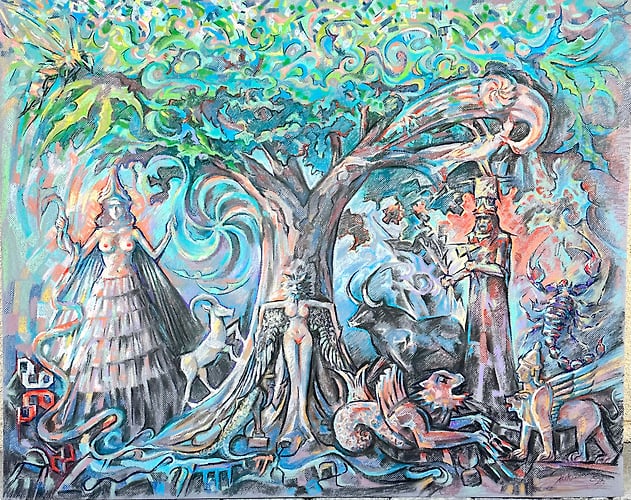
The Divination of the Sosy Tree
Pastel and charcoal on paper, August 2023.
I have used many themes and symbols, not necessarily relevant, such as ancient Mesopotamian gods and goddesses, but if you were transported back into antiquity, and witnessed all the spiritual forces and influences that shaped our Mythology and Pantheon, you would embrace every element of this artwork. I will expect the onlooker
to discover all the hidden images and comment.
King Ara “the Beautiful” was a descendant of Hayk, the patriarch of the Armenians. His grandson, Anushavan, was known to be devoted to the veneration and divination of the Sosi tree, thus earning his title “Sosanver” which means “devoted to Sosi”. “For he had been dedicated to the cult of the plane trees at Aramaneak in Armavir. The murmurings of their foliage and the direction of their movement at the gentler and stronger blowing of the wind was used for divination in the land of the Armenians, and that for a long time”(Moses Khorenatsi)
The Sosi, also called “plane” or “sycamore” in English, Platano in Greek, and “Chinar” in other Eastern languages, was a divine tree worshipped in ancient Armenia. The worship probably had its origins around the tree of life, known as the Genats tree, which was found to be the predecessor of the Poplar and Sosi trees, and which can be found on thousands of murals and inscriptions from
Mesopotamia, and a popular theme and symbol in ancient Armenian culture. Sacred Altars to the Gods were erected among these trees, which were arranged in large groves, such as the sacred forest of sycamores near the ancient capital of Armavir. Priests and
druids would listen to the rustling and “murmuring” of the leaves and make predictions, just like the oracle of Delphi. The Armenian word “Sosapyun” was used to describe this unique and mesmerizing sound of the Sosy leaves.

